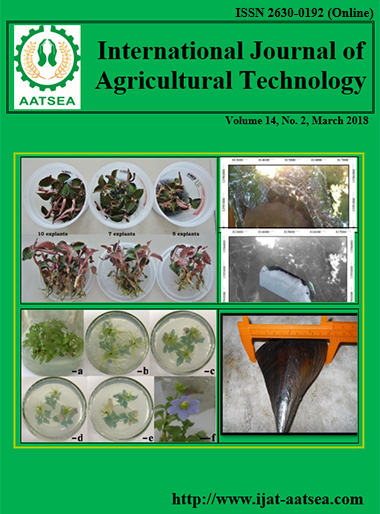Molecular Identification of Chaetomium species from Soil in Vietnam
Main Article Content
Abstract
This study reported some species of the Chaetomiaceae from collected soil samples in Vietnam. Soil samples were taken from dragon fruit crop cultivation in Tien Giang and Long An provinces in 2017. All species of Chaetomiaceae were isolated from soil samples by soil baiting technique. All species were identified based on the morphological characteristics and phylogenetic analysis of β-tubulin gene. At least four species of the Chaetomiaceae family were identified, including Arcopilus aureus, Arcopilus cupreus, Chaetomium cochliodes and Chaetomium globosum. These strains were strongly antagonistic activity against Neoscytalidium dimidiatum causing brown spot disease of Hylocereus undatus (white-fleshed pitahaya) in Vietnam. Further research would be done the control mechanism and acute and dermal toxicology test for environmental safety. Finally it maybe formulate as biological fungicide to control this serious disease in the field.
Article Details

This work is licensed under a Creative Commons Attribution-NonCommercial-NoDerivatives 4.0 International License.
References
Doyle, J. J. and Doyle, J. L. (1990). Isolation of plant DNA from fresh tissue. Focus 12:13-15.
Le, T. A. H., Nguyen, T. H., Nguyen, T. H. P., Nguyen, T. T. N., Nguyen, T. Q., Nhu, V. C., Nguyen. T. M. and Soytong K. (2005). Chaetomiums fungi applied research in the production of biological products and plant protection fungal disease prevention. Scientific and Technical Review Report, Agricultural Genetics Institute, MARD.
Nguyen, T. H., Nguyen, N. A. T. and Nguyen, V. H. (2014). The study identified factors, morphological and biological properties of pathogenic fungi Neoscytalidium dimidiatum causing brown spot on the dragon fruit plants (Hylocereus undatus). Proceedings of the 13th National Conference, University of Agriculture and Forestry, Ho Chi Minh City, 6-7 June 2014. pp. 114-120.
O’Donnell, K. and Cigelnik, E. (1997). Two divergent intragenomic rDNA ITS2 types within a monophyletic lineage of the fungus Fusarium are nonorthologous. Molecular Phylogenetics and Evolution 7:103-116.
Soytong, K. and Quimio, T. H. (1989). A taxonomic study on the Philippine species of Chaetomium. The Philippine Agriculturist 72:59-72.
Soytong, K. (1991). Species of Chaetomium in Thailand soils. Thai Phytopathology 11:86-94.
Thiep, N. V. and Soytong, K. (2015). Chaetomium spp. as biocontrol potential to control tea and coffee pathogens in Vietnam. Journal of Agricultural Technology 11:1381-1392.
Vo, T. T. O., Le, D. D. and Phan, T. T. H. (2015). Determination of alternate host of the Fungus Neoscytalidium dimidiatum (Penz.) Crous & Slippers, causing the dragon fruit brown spot disease. Vietnamese Journal of Plant Protection 5:34-39.
von Arx, J. A., Guarro, J. and Figueras, M. J. (1986). Ascomycete genus Chaetomium. Beih. Nova Hedwigia 84:1-162.
Wang, X. W., Houbraken, J., Groenewald, J. Z., Meijer, M., Andersen, B., Nielsen, K. F. and Samson, R. A. (2016a). Diversity and taxonomy of Chaetomium and Chaetomium-like fungi from indoor environments. Studies in Mycology 84:145-224.
Wang, X. W., Lombard, L., Groenewald, J. Z., Li, J., Videira, S. I. R., Samson, R. A. and Crous, P. W. (2016b). Phylogenetic reassessment of the Chaetomium globosum species complex. Persoonia: Molecular Phylogeny and Evolution of Fungi 36:83-133.


